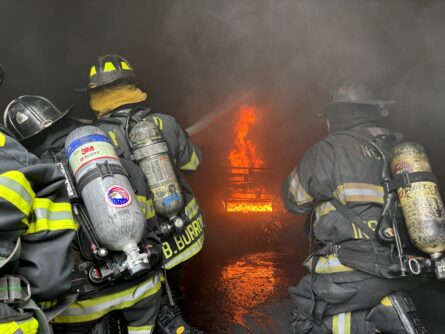
Photos from the Firefighters Association of the State of New York
The Occupational Safety and Health Administration is proposing new emergency response standards that if adopted could make it harder for volunteer departments in Nassau County to operate.
The county has 71 volunteer fire departments that cover 64 Villages and three towns.
OSHA was created in 1971. It is a regulatory agency of the U.S. Department of Labor that is responsible for inspecting and examining workplaces.
The Fire Brigades rule is a set of requirements applied to fire brigades, industrial fire departments, and private or contractual fire departments by OSHA; it was created in 1980 and has only had minor adjustments since then.
It mandates employers take responsibility for all department members’ training, education and protective gear.
The Emergency Response Standard OSHA is considering replacing the existing Fire Brigades Standard, which would expand the scope of OSHA’s standard to include a broad range of hazards emergency responders encounter during emergency response activities.
If adopted, it would align the current emergency standard with the Federal Emergency Management Agency’s (FEMA) National Response Framework and modernize it to align with the current industry consensus standards issued by the National Fire Protection Association on the safe conduct of emergency response activities.
OSHA standards do not apply to volunteer emergency responders. However, in states like New York with OSHA-approved state plans volunteers may be treated as employees under state law.
Volunteer fire departments throughout Long Island and New York have been advocating for their exemption to these rules, arguing that they are not economically feasible.
Timothy Hannigan, general counsel to the Firefighters Association of the State of New York, argued in written testimony that compliance with the proposed standard is not economically viable for volunteer fire departments to comply with, and it would disproportionately burden volunteer first responders and the communities they serve.
“OSHA’s one-size fits all approach in the proposed rule was fundamentally flawed from the outset because of the disparate needs and financial realities of volunteer fire departments,” Hannigan wrote.
In a statement on Sept. 17, OSHA pushed back against some of the economic arguments laid out by volunteer fire departments.
“OSHA preliminarily determined, based on the limited evidence available at the time, that the proposed rule would be economically feasible for volunteer organizations. OSHA had sought information about the potential impact of the rule on volunteer organizations, but it did not have sufficient evidence to show that the rule would be infeasible for these organizations.” the agency wrote.
Public hearings on the proposed rule will occur virtually from Nov. 12 through Dec. 4.

